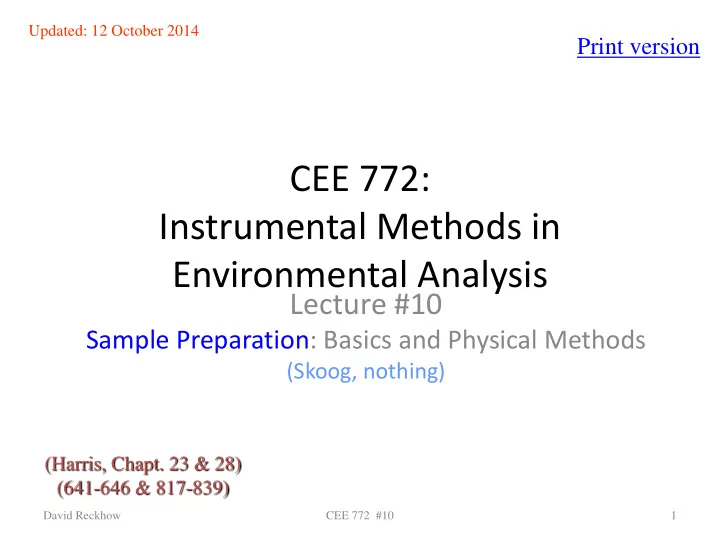

Updated: 12 October 2014 Print version CEE 772: Instrumental Methods in Environmental Analysis Lecture #10 Sample Preparation: Basics and Physical Methods (Skoog, nothing) (Harris, Chapt. 23 & 28) (641-646 & 817-839) David Reckhow CEE 772 #10 1
Other References Solid Phase Extraction: Principles and Practice, by E.M. Thurman and M.S. Mills, Wiley, 1998 Extraction Methods for Environmental Analysis, by J.R. Dean, Wiley, 1998 Sample Preparation in Chromatography by S.C. Moldoveanu and V. David, Elsevier, 2002 Sample Preparation for Trace Elemental Analysis, by Z. Mester & R.L. Sturgeon, Elsevier, 2003 Handbook of Derivatives for Chromatography, by K. Blau & J. Halket, 2 nd Edition, Wiley, 1993 Handbook of Analytical Derivatization Reactions, by D.R. Knapp, Wiley, 1979 David Reckhow CEE 772 #10 2
Sample Preparation Reasons for pre-treatment Improve method sensitivity Concentrate analyte Change chemical nature of analyte to get greater detector response Remove interfering substances (isolation) Solvent (or phase) transfer for compatibility with analytical method David Reckhow CEE 772 #10 3
Physical Pretreatment o Concentration o Phase change o Freeze concentration, freeze drying, vacuum distillation, atmospheric pressure distillation o Membrane processes o Reverse osmosis (RO), ultrafiltration (UF), dialysis o Isolation o Gas transfer/ gas stripping o Purge & trap (P&T), closed loop stripping (CLSA), headspace analysis o Solvent Extraction (SE) o Liquid-liquid extraction (LLE), soxhlet extraction, sonication extraction, supercritical fluid (SFE) o Solid-phase Extraction (SPE) or adsorption o Ion exchange resins, hydrophobic resins, activated carbon, polar adsorbents, micro methods (SPME) David Reckhow CEE 772 #10 4
Physical Pretreatment (cont.) Change in Solvent/Phase Solid to liquid Many of the same techniques as solvent extraction Liquid to liquid Solvent exchange: again similar to earlier solvent extraction David Reckhow CEE 772 #10 5
Chemical Pretreatments Derivatization Alkylation Silylation Detector-specific derivatives Digestion Complexation Reduction David Reckhow CEE 772 #10 6
Liquid/liquid extraction Transfer from one liquid to another Solvents: Water Organics: diethyl ether, pentane, methyl tertiary butyl ether, ethyl acetate Rely on equilibrium partitioning ← → K S S ( aq ) ( sol ) David Reckhow CEE 772 #10 7
Liquid/Liquid Extraction Partition Coefficients Relative solubility of an analyte in an organic solvent to its solubility in water C = s K D C w Or more generally, the relative solubilities in two different and [ ] immiscible solvents S K = 2 [ ] S 1 David Reckhow CEE 772 #10 8
LLE calculations Fractional extraction efficiency The mass of analyte in the organic solvent divided by the total analyte mass m = s f + e m m s w C V = s s f + e C V C V s s w w David Reckhow CEE 772 #10 9
LLE Calculations (cont.) o Divide numerator and denominator by C s V s 1 = f e C V + w w 1 C V s s o And substituting for the partition coefficient 1 = f e 1 V + w 1 K V D s David Reckhow CEE 772 #10 10
Example Chloroform has a pentane:water partition coefficient of 50 at 20°C. What is the fractional extraction efficiency for a system consisting of 1 liter of aqueous solution and a. 50 mL pentane? b. 25 mL pentane, followed by phase separation, then a second 25 mL volume of pentane? 1 = = f 0 . 714 e 1 1000 + 1 50 50 1 = = f 0 . 555 e 1 1000 + 1 50 25 David Reckhow CEE 772 #10 11
Example (cont.) however, for the second extraction, the concentration is reduced to 1-ƒe of the original, so that the overall, two-step serial extraction efficiency, ƒ2e, is: ( ) = + − f f 1 f f 2 e e e e ( ) = + − = 0 . 555 1 0 . 555 0 . 555 0 . 802 f 2 e Or 80.2% David Reckhow CEE 772 #10 12
LLE Calculations (cont.) Writing a mass balance on the analyte before and after extraction = + C V V C V C wi w w w s s Allows us to calculate the concentration factor achieved by extraction C 1 = s C V ≈ s w And if K D is large: 1 V C + s wi C V wi s K V D w David Reckhow CEE 772 #10 13
Effect of speciation Distribution Coefficients total concentrat ion in phase 2 = D total concentrat ion in phase 1 Which for a basic analyte partitioning between water and [ ] an organic solvent becomes B = [ ] 2 D [ ] + + B BH [ ] [ ] 1 1 + H B And since: = [ ] K a + BH Then: • K K = = α [ ] a D K + + 1 K H a David Reckhow CEE 772 #10 14
Complexation Methods Importance of Speciation Ligands David Reckhow CEE 772 #10 15
Complexation methods (cont.) Extraction of metal ions by dithizone into carbon tetrachloride. David Reckhow CEE 772 #10 16
Other issues in LLE Salting out Increases K D Produces more stable interface, fewer emulsions Addition of colored reagent Improve visual identification of interface e.g., CuSO 4 David Reckhow CEE 772 #10 17
To next lecture David Reckhow CEE 772 #10 18
Recommend
More recommend